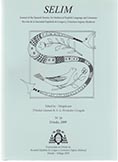Abstract
The article investigates the diachronic interaction between phonology and morphology in the domain of morphonotactics, one of whose basic assumptions is that the relationship between the phoneme sequences which a language allows lexically and the ones which it produces through morphological operations is systematic, functional, and governed by domain specifi c dynamics. The historical development of consonant clusters such as /nd/ represents a good testing ground for this assumption: taking Middle English as a whole, it is possible to say that /nd/ could occur both at the end of morphologically simple word forms and in the past tense and past participle forms of verbs whose stems ended in /n/. Word internal fi nal /nd/ clusters had already existed in Old English but the possibility of creating them through past tense formation represented a Middle English innovation brought about through schwa loss—whereby word fi nal phoneme sequences (exclusively lexical originally) came to be joined by numerous (morphologically-produced) new homophones. Such a change can be expected to have produced observable eff ects either in the domain of lexical phonotactics or in morphology, or in both. After outlining the basics of morphonotactic theory and some of its more specific predictions (e.g. a preference for purely lexical phonotactic configurations and morphologically produced ones to be non-homophonous), I will then discuss what eff ects changes in the morphonotactic system of a language can be expected to have, and will fi nally propose that the peculiar way in which EME vowel lengthening before /nd/ clusters seems to have been implemented might indeed represent such an effect.
Keywords: Phonology, Morphology, (Mor-)phonotactics, consonant clusters, Middle English, homophones, vowel lengthening.




